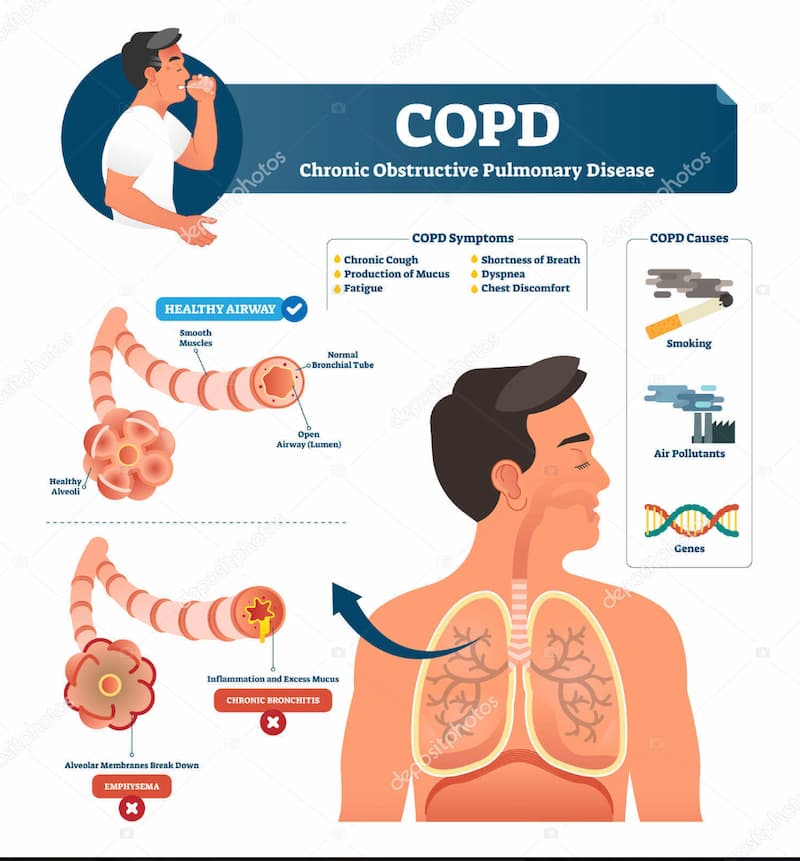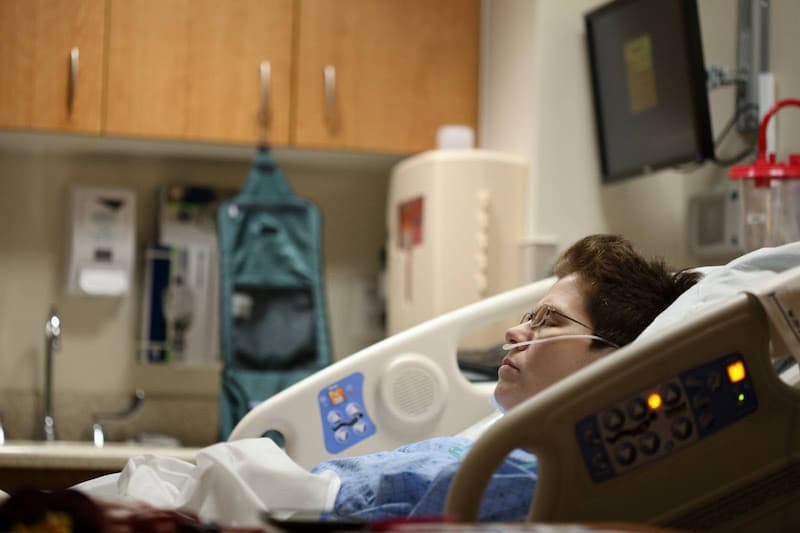Chronic obstructive pulmonary disease (COPD) is one of the most common lung diseases in the world. According to a study published in the Lancet in 2022, there are about 480 million patients with this condition worldwide. A projection suggests that by 2050 there will be approximately 645.6 million people with COPD.
Unfortunately, COPD doesn’t get enough attention and funding, even if it causes global morbidity and mortality—some research shows that the disease is going to be the leading cause of death. For effective treatment of the disease, recognition of the early signs of COPD is a matter of urgency.
In this article, you can find out whether you’re at risk of getting COPD and what are the early warning signs of COPD to start the treatment on time.
Types of COPD: Chronic Bronchitis and Emphysema
Chronic bronchitis and emphysema are the two most common conditions of COPD that are accepted by the majority of specialists. Let’s take a detailed look at each disease.
What is chronic bronchitis?
It is a long-term inflammation of the bronchi that leads to impaired lung function, such as increased mucus production. Patients with this disease suffer from breathing problems, chronic infections, and an uncontrolled cough.
What is emphysema?
The other type of COPD is emphysema. The disease damages the air sacs and makes them less elastic, so the patient develops a decrease in respiratory function and breathlessness. Unfortunately, the damage is permanent, and emphysema “holes” in the lungs can’t be cured.
Some specialists also believe that asthma should be considered a chronic obstructive pulmonary disease, as this condition also provokes breathing problems and increases mucus production.

Risk Factors for COPD
Being aware of your risk factors can help you identify early signs of COPD. The following reasons may raise your COPD’s risks.
Smoking and secondhand smoke exposure
Smoking and secondhand smoke is recognised as the most important causative factors for COPD. Scientists find more and more evidence that dangerous habits are the key factor in the disease. As an example, patients who quit smoking showed a reduction in COPD’s symptoms progression. Also, smokers are more likely to develop chronic obstructive pulmonary disease, especially as they age.
Not smoking is a simple way for people in high-income countries to prevent the development of COPD. However, in the developing world, smoking cessation might not be enough.
Environmental and occupational exposures
The primary factors causing COPD in the developing world include environmental issues and poor occupational conditions. For example, there is some epidemiological evidence that air pollution is closely related to different respiratory diseases, and COPD is included in that list. COPD can have long-term consequences for those residing in disadvantaged environments.
The other underestimated risk factor is occupational exposure. Some jobs and workplaces put employees in a position where they can’t avoid constant lung irritation by breathing in vapours, gases, and dust. These people are at high risk of developing COPD.
Genetic factors and alpha-1 antitrypsin deficiency
Genetics plays a role in the development of COPD. The genetics of the patient may affect the body’s susceptibility to different gases and smoking. Consequently, people who can’t tolerate tobacco might develop early symptoms of COPD in a short time.
However, scientists name one specific COPD genetic risk factor: alpha 1 antitrypsin (AAT) deficiency. It is really rare and causes only 1-2% of the disease.
Врезка: What is AAT?
AAT is an extremely important protein for the lungs. If the patient is deficient in this protein, their lungs are more likely to develop COPD as a response to smoking and environmental pollution. Studies show that AAT deficiency runs in families. Therefore, early diagnosis can help prevent COPD and other lung diseases.
Get a free online consultation
Please, contact our medical advisor to discuss your health condition with a specialist in regenerative medicine. You can also leave your contact details for a callback. It is free and confidential.
Common Early Signs and Symptoms of COPD
There are several early warning signs of COPD that everyone should be aware of to start the treatment on time.
Here is the list of the most common early symptoms of COPD:
Chronic cough and sputum production
Epidemiologic studies show that chronic cough and sputum production might be early warning signs of COPD. These factors are also associated with the progression of COPD, which might lead to fatal outcomes. So if you spot the symptoms, it is a good idea to consult a doctor and do COPD tests.
Shortness of breath (dyspnea)
Dyspnea is a subjective, mostly unpleasant experience of discomfort with breathing. And even if healthy people can feel this way from time to time, it is considered an early sign of COPD.
Healthcare providers note that the severity and magnitude of dyspnea increase with the progress of the disease: in the early stages of COPD it might be bearable, but without proper care, the shortness of breath appears even with minor physical exertion.
Wheezing and chest tightness
Patients with COPD often experience wheezing and chest tightness. Wheezing is an unpleasant sound that occurs when a person is trying to breathe, and chest tightness makes it feel like you can’t take a deep breath.
Frequent respiratory infections
Patients with COPD are known for suffering from respiratory infections quite frequently, as COPD destroys impairment of the innate immune system, and bacteria can colonize the respiratory tract easily. The condition appears in the early stages of COPD.
Fatigue and decreased exercise tolerance
All of the above negatively affects the level of physical activity of patients. People start getting tired quickly and struggle to perform even light physical activities. Because of these difficulties, patients with COPD may be recognized as disabled.

Differentiating COPD from Other Respiratory Conditions
Now that you know what are the early signs of COPD, you can recognise it from similar respiratory conditions. Here is a list of diseases that are easily confused with COPD:
Asthma: similarities and differences in symptoms and triggers
Similarities:
- Shortness of breath,
- Cough.
Differences:
- Asthma can get better as symptoms come and go.
- COPD symptoms are constant and get worse over time.
Bronchitis: acute vs. chronic bronchitis
Bronchitis can be acute (short-term) or chronic (long-term). The first type of disease can be cured, while the second can’t.
Other respiratory conditions that may mimic COPD symptoms
These conditions can share symptoms such as coughing, shortness of breath, and chest pain:
- Cardiac Arrhythmia,
- Pulmonary Embolism,
- Tuberculosis (TB).
To differentiate them from COPD, a patient needs a proper medical evaluation and diagnostic tests.
Importance of Early Diagnosis and Treatment
It is important to diagnose COPD as soon as possible, as the early stages of COPD symptoms are much easier to treat.
Impact of early intervention on disease progression
As undiagnosed early-stage disease, particularly in symptomatic patients, is likely to become more severe with time, early intervention helps to slow COPD progression.
Benefits of early diagnosis for managing symptoms and improving quality of life
Studies show that people with undiagnosed COPD are at higher risk of poor quality of life and developing disability. However, if patients with COPD get the proper help on time, their symptoms can be controlled, which is not only beneficial for people but for healthcare systems as well.
Available diagnostic tests for COPD
To diagnose COPD, your attending physician will analyze your health history and then conduct a physical exam if your provider suspects you may have COPD. Some of the tests are:
- spirometry
- alpha-1 testing
- chest X-ray
- CT Scan
- oximetry.
When to Seek Medical Evaluation
When it comes to COPD, it’s best to err on the side of caution and get tested if you have symptoms.
Importance of consulting a healthcare professional for proper evaluation and diagnosis
Only a qualified doctor can make a final diagnosis. If a specialist diagnoses COPD in the early stages, this will help significantly slow down the development of symptoms and maintain the same standard of living for many years.
Contact us
Get a free online consultation to learn about the expected results of stem cell therapy for your case, what is the cost of the treatment, and its duration.
List of References:
Global, regional, and national prevalence of, and risk factors for, chronic obstructive pulmonary disease (COPD) in 2019: a systematic review and modeling analysis. The Lancet. Published :March 10, 2022DOI:https://doi.org/10.1016/S2213-2600(21)00511-7
S.A. Quaderi, J.R. Hurst. (2018). The unmet global burden of COPD, Glob Health Epidemiol, 3: e4. https://doi.org/10.1017/gheg.2018.1
Rafael Laniado-Laborín. (2009). Smoking and Chronic Obstructive Pulmonary Disease (COPD). Parallel Epidemics of the 21st Century, Int J Environ Res Public Health, 6(1): 209–224. 10.3390/ijerph6010209
Rui-Rui Duan, Ke Hao, Ting Yang.(2020). Air pollution and chronic obstructive pulmonary disease, Chronic Dis Transl Med., 6(4): 260–269. 10.1016/j.cdtm.2020.05.004
Alpha-1 Antitrypsin Deficiency. National Heart, Lung and Blood Institute. Available from: https://www.nhlbi.nih.gov/health/alpha-1-antitrypsin-deficiency. (Accessed 05.04.24)
Nicola Murgia, Angela Gambelunghe. (2022). Occupational COPD—The most under‐recognized occupational lung disease?Respirology., 27(6): 399–410. 10.1111/resp.14272
Marilyn Foreman, Michael Campos, Juan C. Celedón. (2012). Genes and COPD, Med Clin North Am.,96(4): 699–711. 10.1016/j.mcna.2012.02.006
Pierre-Régis Burgel, Pascale Nesme-Meyer, Pascal Chanez, Denis Caillaud, Philippe Carré, Thierry Perez, Nicolas Roche, Initiatives Bronchopneumopathie Chronique Obstructive (BPCO) Scientific Committee. (2008). Cough and sputum production are associated with frequent exacerbations and hospitalizations in COPD subjects, ORIGINAL RESEARCH | COPD, 135(4):975-982. 10.1378/chest.08-2062
Darcy D Marciniuk, Donna Goodridge, Paul Hernandez, Graeme Rocker, Meyer Balter, Pat Bailey, Gordon Ford, Jean Bourbeau, Denis E O’Donnell, Francois Maltais, Richard A Mularski, Andrew J Cave, Irvin Mayers, Vicki Kennedy, Thomas K Oliver, Candice Brown, Canadian Thoracic Society COPD Committee Dyspnea Expert Working Group. (2011). Managing dyspnea in patients with advanced chronic obstructive pulmonary disease: A Canadian Thoracic Society clinical practice guideline, Can Respir J., 18(2): 69–78. 10.1155/2011/745047
Peter Lange. (2009). Chronic obstructive pulmonary disease and risk of infection, Pneumonol Alergol Pol, 77(3):284-8. PMID: 19591100
T Welte, C Vogelmeier, A Papi. (2015). COPD: early diagnosis and treatment to slow disease progression, Int J Clin Pract., 69(3):336-49. 10.1111/ijcp.12522
Ching-Hsiung Lin, Shih-Lung Cheng, Chiung-Zuei Chen, Chia-Hung Chen, Sheng-Hao Lin, Hao-Chien Wang. (2023). Current Progress of COPD Early Detection: Key Points and Novel Strategies. Int J Chron Obstruct Pulmon Dis., 18: 1511–1524. 10.2147/COPD.S413969
Medical Advisor, Swiss Medica doctor








